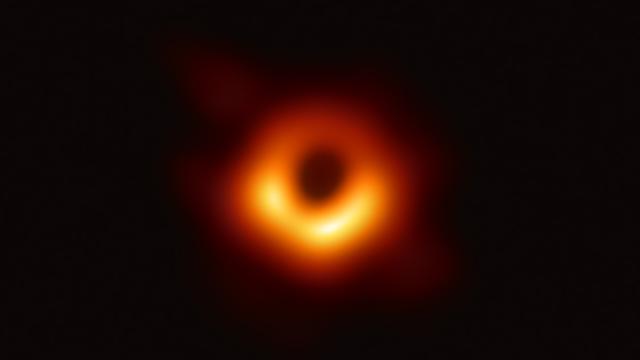Scientists are learning important new things about the first-ever directly imaged black hole, including behaviours consistent with Einsteinian theory, but it’s also showing an unexpected feature in the form of a very wobbly ring.
Seems like forever ago, but we finally got to feast our eyes on the apparently unseeable back in April 2019, when this incredible image of a supermassive black hole was first released. Of course, we can’t actually “see” the black hole, because, as any 6-year-old will happily tell you, black holes have a habit of sucking up light. What the picture does show, however, is an asymmetric ring, known as the black hole’s shadow, of superheated gas swirling around the black hole’s event horizon — that boundary beyond which light cannot escape.
This particular black hole, with the mass of 6.5 billion Suns, is located 55 million light-years away in the Messier 87 galaxy, or M87 for short. The black hole, designated M87*, was imaged by the Event Horizon Telescope in April 2019, in what was a historic scientific achievement. The image provided a static view of M87*, but new research published this week to The Astrophysical Journal shows it’s now possible to study physical changes to this black hole and its surrounding area over time.

Astronomers with the EHT project observed M87* for a one-week period in April 2017, which didn’t afford them enough time to track dynamic aspects of the system, like changes to its shape. But the researchers have now done exactly that, by studying archival EHT data going back to 2009.
“If you want to see a black hole evolve over a decade, there is no substitute for having a decade of data,” said Maciek Wielgus, an astronomer at the Centre for Astrophysics at Harvard & Smithsonian and the lead author of the new paper, in a press release.
EHT is a large telescope array composed of radio dishes strategically placed around the globe. The system achieved full operational power in 2017, and, with dishes at five different locations, it resulted in a kind of “Earth-sized radio dish,” as it was described in a press release put out by the Max Planck Institute for Radio Astronomy. Importantly, however, an early prototype of the EHT array was gathering important astronomical information while the system was being built. Specifically, observations of the monstrous black hole were gathered from 2009 to 2012 from three sites, and in 2013 from four sites.
“While these observations do not contain enough information to produce images, they are sufficient to constrain simple geometric models,” wrote the authors in the new study.
A statistical modelling technique, plus some educated guessing, allowed the researchers to chart changes to the system over time, in a process that included observations gathered by EHT until 2019.
As the models showed, the overall shape of this thing has remained constant over the past 10 years, which is good news if you’re a fan of Albert Einstein. The fixed diameter of the crescent shadow for a black hole of this size agrees with a prediction drawn from his famous theory of general relativity.
“In this study, we show that the general morphology, or presence of an asymmetric ring, most likely persists on timescales of several years,” said Kazu Akiyama, an MIT scientist and study co-author, in the Harvard & Smithsonian press release. “This is an important confirmation of theoretical expectations as the consistency [of multiple observations] gives us more confidence than ever about the nature of M87* and the origin of the shadow.”
This constancy aside, the astronomers did notice a major difference, as the asymmetric ring appears to be wobbling to a significant degree. The ring’s shape hasn’t changed in the past decade, but it has rotated.
“Actually, we see quite a lot of variation there,” said Wielgus.
Thomas Krichbaum, an astronomer at MPIfRA and a co-author of the study, said the “data analysis suggests that the orientation and fine structure of the ring varies with time,” which is important as it provides a “first impression on the dynamical structure of the accretion flow, which surrounds the event horizon,” as he explained in the Max Planck press release.
Accretion flow — the rate of material streaming into a black hole — for M87* appears to be variable. As the authors speculate, the glowing gas in the ring is in a highly turbulent state, the result of magnetic fields, and this is what is causing the shifting appearance of the black hole over time. This is super exciting, because the “dynamics of this wobbling will allow us to [measure] the accretion flow,” said Anatua.
With this paper, we’ve now entered into a new era of studying the intimate areas around black holes. Astronomers can track changes to these exotic systems over time, and they should be able to study not just accretion flow but also related phenomena, such as relativistic jets. The physical characteristics of relativistic jets — outflows of highly energetic particles — are “key to understanding the interactions with the surrounding medium in a black hole’s host galaxy,” said Richard Anantua, study co-author, in the release. Observations of accretion flow will also provide another way for scientists to test general relativity, a theory that has held up pretty well so far.
